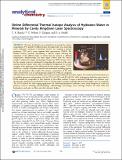Online differential thermal isotope analysis of hydration water in minerals by cavity ringdown laser spectroscopy
Abstract
We have developed a new method for measuring the isotopic composition (δ18O and δD) of different types of bonded water (e.g., molecular water, hydroxyl) contained in hydrated minerals by coupling a thermal gravimeter (TG) and a cavity ringdown laser spectrometer (CRDS). The method involves precisely step-heating a mineral sample, allowing the separation of the different types of waters that are released at different temperatures. Simultaneously, the water vapor evolved from the mineral sample is analyzed for oxygen and hydrogen isotopes by CRDS. Isotopic values for the separate peaks are calculated by integrating the product of the water amounts and its isotopic values, after correcting for background. We provide examples of the application of the differential thermal isotope analysis (DTIA) method to a variety of hydrous minerals and mineraloids including gypsum, clays, and amorphous silica (opal). The isotopic compositions of the total water evolved from a set of natural gypsum samples by DTIA are compared with the results of a conventional offline water extraction method followed by CRDS analysis. The results from both methods are in excellent agreement, and precisions (1σ) for δ18O (±0.12‰) and δD (±0.8‰) of the total gypsum hydration water from the DTIA method are comparable to that obtained by the offline method. A range of analytical challenges and solutions (e.g., spectroscopic interferences produced by VOCs in natural samples, isotopic exchange with structural oxygen, etc.) are discussed. The DTIA method has wide ranging applications for addressing fundamental problems across many disciplines in earth and planetary sciences, including paleoclimatology, sedimentology, volcanology, water exchange between the solid earth and hydrosphere, and water on Mars and other planetary bodies.
Citation
Bauska , T K , Walters , G , Gázquez , F & Hodell , D A 2018 , ' Online differential thermal isotope analysis of hydration water in minerals by cavity ringdown laser spectroscopy ' , Analytical Chemistry , vol. 90 , no. 1 , pp. 752-759 . https://doi.org/10.1021/acs.analchem.7b03136
Publication
Analytical Chemistry
Status
Peer reviewed
ISSN
0003-2700Type
Journal article
Description
This research was supported by the ERC WIHM Project (#339694) to D.A.H.Collections
Items in the St Andrews Research Repository are protected by copyright, with all rights reserved, unless otherwise indicated.

